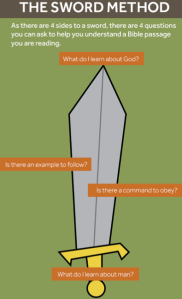First Third:
Express joy in Christ together
Vision 100
Questions:
How are you doing?
How did you obey last week’s teaching?
Who are you witnessing to?
Who has come to faith? Are they witnessing to those in their circle?
Who are you training to become a reproducing disciple? Are they training others?
Second Third:
DO stick to the story.
DON’T talk about politics; DON’T chase rabbit trails; DON’T focus on minor points in the passage.
DON’T talk about religion. DON’T dominate the conversation.
This is a true story from the Bible.
Genesis 2:15-18, 2:19-3:19
15The LORD God took the man and put him in the garden of Eden to work it and keep it. 16And the LORD God commanded the man, saying, “You may surely eat of every tree of the garden, 17but of the tree of the knowledge of good and evil you shall not eat, for in the day that you eat of it you shall surely die.”18Then the LORD God said, “It is not good that the man should be alone; I will make him a helper fit for him.” . . .
21So the LORD God caused a deep sleep to fall upon the man, and while he slept took one of his ribs and closed up its place with flesh. 22And the rib that the LORD God had taken from the man he made into a woman and brought her to the man. 23Then the man said, “This at last is bone of my bones and flesh of my flesh; she shall be called Woman, because she was taken out of Man.” 24Therefore a man shall leave his father and his mother and hold fast to his wife, and they shall become one flesh. 25And the man and his wife were both naked and were not ashamed.
3:1 Now the serpent was more crafty than any other beast of the field that the LORD God had made. He
said to the woman, “Did God actually say, ‘You shall not eat of any tree in the garden’?” 2And the woman said to the serpent, “We may eat of the fruit of the trees in the garden, 3but God said, ‘You shall not eat of the fruit of the tree that is in the midst of the garden, neither shall you touch it, lest you die.'” 4But the serpent said to the woman, “You will not surely die. 5For God knows that when you eat of it your eyes will be opened, and you will be like God, knowing good and evil.” 6So when the woman saw that the tree was good for food, and that it was a delight to the eyes, and that the tree was to be desired to make one wise, she took of its fruit and ate, and she also gave some to her husband who was with her, and he ate. 7Then the eyes of both were opened, and they knew that they were naked. And they sewed fig leaves together and made themselves loincloths.8And they heard the sound of the LORD God walking in the garden in the cool of the day, and the man and his wife hid themselves from the presence of the LORD God among the trees of the garden. 9But the LORD God called to the man and said to him, “Where are you?” 10And he said, “I heard the sound ofyou in the garden, and I was afraid, because I was naked, and I hid myself.” 11 He said, “Who told you that you were naked? Have you eaten of the tree of which I commanded you not to eat?” 12The man said,”The woman whom you gave to be with me, she gave me fruit of the tree, and I ate.” 13Then the LORD God said to the woman, “What is this that you have done?” The woman said, “The serpent deceived me, and I ate.” 14The LORD God said to the serpent, “Because you have done this, cursed are you above alllivestock and above all beasts of the field; on your belly you shall go, and dust you shall eat all the days of your life. 15I will put enmity between you and the woman, and between your offspring and her offspring; he shall bruise your head, and you shall bruise his heel.” 16To the woman he said, “I will surely multiply your pain in childbearing; in pain you shall bring forth children. Your desire shall be for your husband, and he shall rule over you.” 17And to Adam he said, “Because you have listened to the voice of your wife and have eaten of the tree of which I commanded you, ‘You shall not eat of it,’ cursed is the ground because of you; in pain you shall eat of it all the days of your life; 18thorns and thistles it shall bring forth for you; and you shall eat the plants of the field. 19By the sweat of your face you shall eat bread, till you return to the ground, for out of it you were taken; for you are dust, and to dust you shall return.”
This is a true story from the Bible.
Have someone read the story, and then another person tell it.
What does this story tell us about God?
About the man? About the woman? What is their life like at the end of chapter 2?
What does this story tell us about the serpent? About the tree of the knowledge of good and evil?
What happens as a result of their eating the fruit of the tree?
What does this story tell us about the offspring of the woman?
Are there sins to avoid? Promises to claim? Examples to follow? Commands to obey?
Last Third:
Practice telling the story
What will you do differently this week because of this story?
Who will you witness to or share this story with next week?
